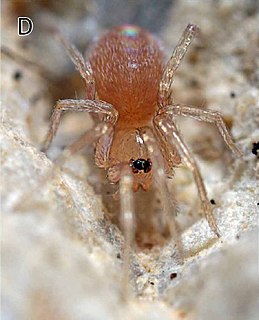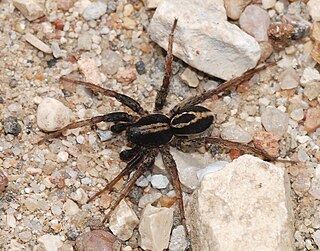
Oonopidae, also known as goblin spiders, is a family of spiders consisting of over 1,600 described species in about 113 genera worldwide, with total species diversity estimated at 2000 to 2500 species. The type genus of the family is OonopsKeyserling, 1835.

Phyxelididae is a family of araneomorph spiders first described by Pekka T. Lehtinen in 1967 as a subfamily of Amaurobiidae, and later elevated to family status as a sister group of Titanoecidae.

Cyatholipidae is a family of spiders first described by Eugène Simon in 1894. Most live in moist montane forest, though several species, including Scharffia rossi, live in dry savannah regions. They occur in Africa, including Madagascar, New Zealand and Australia, and one species in Jamaica. Most members of this family hang beneath sheet webs. Fossil species occur in the Eocene aged Bitterfield and Baltic Ambers, suggesting a wider geographic distribution in the past.

Mysmenidae is a spider family with about 135 described species in thirteen genera. The family is one of the least well known of the orb-weaving spiders because of their small size and cryptic behaviour. These spiders are found in humid habitats such as among leaf litter and in caves.
Penestomus is a genus of African araneomorph spiders in the family Penestomidae, and was first described by Eugène Louis Simon in 1902. The genus was formerly included in the family Eresidae, but was elevated to its own family in 2010. It is now considered closer to Zodariidae.

The RTA clade is a clade of araneomorph spiders, united by the possession of a retrolateral tibial apophysis – a backward-facing projection on the tibia of the male pedipalp. The clade contains over 21,000 species, almost half the current total of about 46,000 known species of spider. Most of the members of the clade are wanderers and do not build webs. Despite making up approximately half of all modern spider diversity, there are no unambiguous records of the group from the Mesozoic and molecular clock evidence suggests that the group began to diversify during the Late Cretaceous.

Pandava is a genus of araneomorph spiders in the family Titanoecidae.
Buibui is a genus of African araneomorph spiders in the family Cyatholipidae, and was first described by C. E. Griswold in 2001.
Scharffia is a genus of East African araneomorph spiders in the family Cyatholipidae, and was first described by C. E. Griswold in 1997.
Ambohima is a genus of Malagasy araneomorph spiders in the family Phyxelididae, and was first described by C. E. Griswold in 1990.
Lamaika is a monotypic genus of South African araneomorph spiders in the family Phyxelididae containing the single species, Lamaika distincta. It was first described by C. E. Griswold in 1990, and is only found in South Africa.
Manampoka is a monotypic genus of Malagasy araneomorph spiders in the family Phyxelididae containing the single species, Manampoka atsimo. It was first described by C. E. Griswold, H. M. Wood & A. D. Carmichael in 2012, and is only found on Madagascar.
Matundua is a monotypic genus of South African araneomorph spiders in the family Phyxelididae containing the single species, Matundua silvatica. It was first described by Pekka T. Lehtinen in 1967, and is only found in South Africa.
Namaquarachne is a genus of South African araneomorph spiders in the family Phyxelididae, and was first described by C. E. Griswold in 1990.
Phyxelida is a genus of araneomorph spiders in the family Phyxelididae, and was first described by Eugène Louis Simon in 1894.
Pongolania is a genus of South African araneomorph spiders in the family Phyxelididae, and was first described by C. E. Griswold in 1990. As of June 2019 it contains only two species, found only in South Africa: P. chrysionaria and P. pongola.
Rahavavy is a genus of Malagasy araneomorph spiders in the family Phyxelididae, and was first described by C. E. Griswold, H. M. Wood & A. D. Carmichael in 2012. As of June 2019 it contains only three species, found only on Madagascar: R. fanivelona, R. ida, and R. malagasyana.
Xevioso is a genus of African araneomorph spiders in the family Phyxelididae, and was first described by Pekka T. Lehtinen in 1967.

Vidole is a genus of African araneomorph spiders in the family Phyxelididae, and was first described by Pekka T. Lehtinen in 1967.





